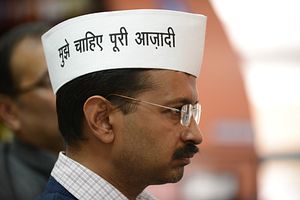When it happened, it was not a mere wave as the exit polls were predicting but a tsunami. With 54.3 percent vote share, the Aam Aadmi Party (AAP) – the Common Man Party – resoundingly won the Delhi state elections, winning 67 out of 70 seats. The BJP was reduced to mere 3 seats though its vote share dipped by only one percent. This is a remarkable win for a party that was comprehensively rejected in the May 2014 parliamentary elections and that had forfeited considerable credibility after it failed to govern Delhi, deciding instead to shun responsibility after a mere 49 days in office. That Delhi voters are ready to give AAP another chance in February 2015 is testament to the hard work that AAP members have done in the last few months to reinstate confidence in their party’s ability to deliver on its key commitments. AAP had emerged out of the peculiar circumstances of the anti-corruption movement in Delhi, so the capital city was always the test case of the workability of the idea of a non-establishment party.
Two successive victories clearly imply that the AAP is an idea whose time has indeed come in Indian politics. Of course, how the AAP governs over the next five years will determine if the idea is sustainable. The party’s agenda still remains largely underdeveloped and full of contradictions. But they seem to have crossed the first hurdle of a democracy: gaining the confidence of the electorate.
One one of the main reasons behind the AAP’s landslide seems to be the complete collapse of the Congress in Delhi much like in the rest of India. This too is remarkable for a party that was in power in Delhi for 15 long years and now finds even its big names struggling to win in their constituencies. Congress, which had bagged eight seats, with a vote share of 24.55 percent, could manage to get only 9.7 percent of the total vote share. The Indian electorate in 2015 is looking for fresh ideas and willing to take risks. A perpetually risk-averse Congress with a tired dynasty at the helm is hardly an appealing option.
But it is the BJP which will inevitably find itself on the backfoot after the staggering losses it has suffered in Delhi. After staking so much on a state election, with Prime Minister Narendra Modi himself asking people to vote for him, the party will have to introspect what went so wrong in just eight months that the nation’s capital refused to listen to Modi, deciding instead to cast their lot with an “anarchist.” It was not AAP but the BJP who made this election a contest between Modi and Arvind Kejriwal, the leader of the AAP. Recognising his mistake from the Lok Sabha elections, Kejriwal from the very beginning refrained from taking on Modi directly, instead prodding the BJP to name its Chief Ministerial candidate. When the BJP did eventually name Kiran Bedi, it was too late in the game and there was widespread dissent within the party. Moreover, the BJP ran a thoroughly negative campaign with the party’s entire top leadership focused on spitting venom on Kejriwal.
For Modi, these election results should lead to some reassessment about his party and his government’s priorities. In India, there is a perpetual election cycle with some state or the other going to elections every few months. In his last eight months, Modi has been campaigning incessantly. The BJP has every right to use their most powerful asset in elections and Modi as the nation’s prime minister can for sure utilize these elections to reach out to the masses. But staking his government’s credibility on every state election is clearly neither desirable nor necessary.
The people of India gave Modi a decisive mandate in May 2014 to govern, and govern effectively. And if AAP’s war cry of anti-corruption is still managing to cut ice with ordinary voters in the nation’s capital, it clearly means that Modi’s governance paradigm leaves much to be desired. Modi’s inability and/or unwillingness to rein in the rabid elements of the Sangh Parivar has also cost the BJP. His governance agenda seems to be losing traction between inane controversies such as ‘Love Jihad’ and ‘Ghar Wapsi’ to repeated incendiary statements by some members of his own party. For a political leader who loves to be in control, this disarray has been widely interpreted as one by design.
Modi will also have to recognise that he is the establishment now. Unlike the Lok Sabha elections where he railed at the establishment and projected himself as the outsider, it was Kejriwal who in Delhi elections was the anti-establishment voice. All the arguments that Modi successfully deployed against the Congress-led political order, Kejriwal has used against the Modi-led establishment at the center. And nothing symbolises the arrogance of political power more than the suit with his name emblazoned all over it. Modi who is fond of reminding voters of his humble origins clearly failed to anticipate the challenge from a muffler-draped Kejriwal.
There are few indications yet that Indians are dissatisfied with the Modi government. In fact, Modi remains India’s tallest leader. But it is time for the BJP to recognise that all is not well and that AAP’s victory will change Indian politics considerably, much of it to the BJP’s detriment, unless it learns its lessons and starts delivering on its commitments. The Indian voter is impatient and is hardly in a mood to wait for long.
































